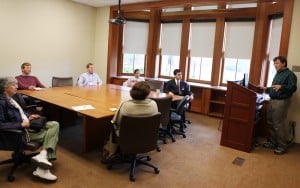Town and Gown at the Geneva Historical Society
John Marks, Curator of Collections
Our collaboration with Hobart & William Smith Colleges has slowly developed over the past 12 years. The occasional intern has grown into classes visiting the exhibits, students researching in the archives, and staff guest-lecturing on campus for classes and alumni events. I think there are several factors:
- Leadership. President Mark Gearan is committed to community service, which begins with students understanding where they live. This has flowed down to the course level.
- Turnover. New professors bring new ideas, among them an emphasis on using the community as a teaching resource.
- The “reformed sinner” ethos. At least one instructor with whom I work attended William Smith and knew no more about Geneva at graduation than when she had arrived. When she returned to teach, she vowed to make her students learn about the city around their campus.
- Word-of-mouth. As we work with professors, they may be telling others about their positive experience.
A common refrain among older people is, “Young people don’t care about history.” It’s fun to test this theory as I work with HWS students. Generally speaking, their interest and attitude corresponds to the reason they’ve come to the museum. First-year students coming to Geneva’s Changing Landscapes for orientation tend to talk amongst themselves rather than actually look at the exhibit. When a visit or lecture is somewhat related to the class, students pay a little more attention. The most engaged groups are research methodology classes in anthropology, women’s studies, and English. Learning to do archival research is the reason they took the class, rather than an assignment beyond their control. They like looking at primary sources – letters, journals, photographs, maps, etc. – and they’re often researching for a final project.
My new favorite anecdote comes from an anthropology research class that visited in February. I broke the class into small groups and gave each table a variety of resources related to a topic. Every group had questions for me, but the most excited students were looking through Sampson Naval Base/World War II files. The four William Smith students found a love letter from a sailor stationed at Sampson to his sweetheart in Massachusetts. They needed to know “what happened next.” Did they get married? Did they settle in Geneva? How could the students find out? I had to explain why it was very unlikely we could answer those questions, but it was nice to see them become invested in the story so quickly.
Our HWS outreach extends to alumni and parents of students. The Colleges offer mini-college classes during Reunion in June and Parents’ Weekend in the fall, and I have presented local history lectures for several years. Most parents see Geneva twice a year for four years, and that may be limited to hotels, restaurants, and the campus. Alumni have little memory of Geneva beyond campus and the bars. The common denominator is that everyone who chooses my lecture wants to learn more. That’s the root of “caring about history”, regardless of age; one needs to have a question and the desire to look for an answer.

